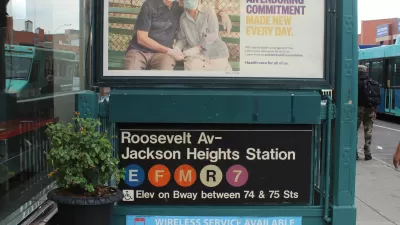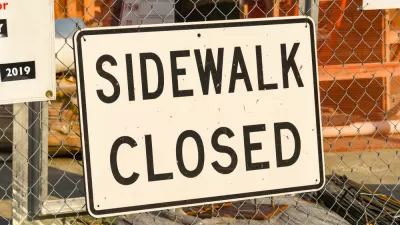The New York Times provides interactive and first-person accounts of the city's failure to provide public transportation to people with disabilities.

Eight years ago, Sasha Blair-Goldensohn was injured by a falling tree branch while on a jog in New York's Central Park. The damage to her spinal cord paralyzed her lower body, and she had to learn to use a wheelchair to get around the city. She writes of experience in navigating the city while in a wheelchair for a big, interactive feature by the New York Times.
As Blair-Goldensohn explains, her story, and those of others like her, show "how large, inflexible bureaucracies with a 'good enough' approach to infrastructure and services can disenfranchise citizens with disabilities, many of whom cannot bridge these gaps on their own."
The article reveals the many failings of public space and transportation infrastructure for people challenged by mobility disabilities. For instance:
New York’s subway is by far the least wheelchair-friendly public transit system of any major American city, with only 92 of the system’s 425 stations accessible. That means fewer than one in four stations can be used by people in wheelchairs when elevators are working — and they frequently are not.
The list of difficulties, bad practices, and bad design and engineering go on, revealing a public transportation system that falling fall short of its responsibilities in providing access and mobility for the entire city's population. And Blair-Goldensohn knows it's possible for the system to be improved—Boston's subway system, built in the same era, is 90 percent wheelchair accessible. Blair-Goldensohn also appeals to the demonstrated benefits to all of society when investments are made to accommodate its most vulnerable members—a phenomenon known as the curb-cut effect.
The article also includes this interactive video, which reveals a first-person perspective on the use of New York's subway system while in a wheelchair.
FULL STORY: New York Has a Great Subway, if You’re Not in a Wheelchair

Alabama: Trump Terminates Settlements for Black Communities Harmed By Raw Sewage
Trump deemed the landmark civil rights agreement “illegal DEI and environmental justice policy.”

Planetizen Federal Action Tracker
A weekly monitor of how Trump’s orders and actions are impacting planners and planning in America.

The 120 Year Old Tiny Home Villages That Sheltered San Francisco’s Earthquake Refugees
More than a century ago, San Francisco mobilized to house thousands of residents displaced by the 1906 earthquake. Could their strategy offer a model for the present?

Ken Jennings Launches Transit Web Series
The Jeopardy champ wants you to ride public transit.

BLM To Rescind Public Lands Rule
The change will downgrade conservation, once again putting federal land at risk for mining and other extractive uses.

Indy Neighborhood Group Builds Temporary Multi-Use Path
Community members, aided in part by funding from the city, repurposed a vehicle lane to create a protected bike and pedestrian path for the summer season.
Urban Design for Planners 1: Software Tools
This six-course series explores essential urban design concepts using open source software and equips planners with the tools they need to participate fully in the urban design process.
Planning for Universal Design
Learn the tools for implementing Universal Design in planning regulations.
Clanton & Associates, Inc.
Jessamine County Fiscal Court
Institute for Housing and Urban Development Studies (IHS)
City of Grandview
Harvard GSD Executive Education
Toledo-Lucas County Plan Commissions
Salt Lake City
NYU Wagner Graduate School of Public Service





























